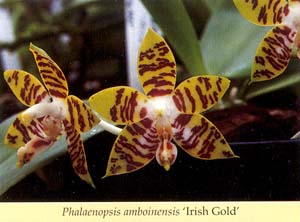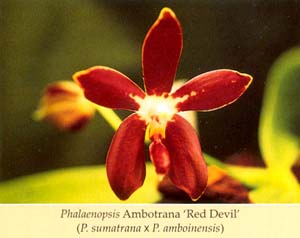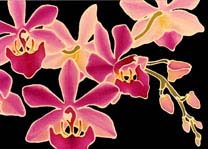Hybridizing with Phalaenopsis Species
by Bill Livingston
Phalaenopsis amboinensis
|
Phalaenopsis
amboinensis is one of my favorite species, and I hope it will be one of
yours. Breeding with it properly results in some fantastic hybrids which
grow very well in the greenhouse. They carry three to five blooms on 10 to
12 inch spikes that can branch. Flowers are white to cream and
lemon-yellow to orange-yellow, and all segments have transverse cinnamon
to mahogany-colored barring. Flowers can range from starry to full-shaped.
As a parent, it passes on heavy substance to its progeny, resulting in
long-lasting flowers, good shape, full petals, and flat flowers in fine
hybrids. The various forms and colors of P. amboinensis have made it one
of the most frequently used species in creating novelty crosses. It has
intensified the colors, spotting and stripes in progeny, and because of
its heavy substance, some of its hybrid offspring are smog resistant. The
yellow form, when bred with the standard white form, has been instrumental
in giving us larger yellows with some markings, and not too many clear
yellows. It takes two, three or more generations of selective breeding to
get clear yellows, as yellow hybridizing has been a problem for many
breeders because of non-germination and small amount of viable seed. One
of its most popular hybrids is P. Princess Kaiulani (P. violacea x P.
amboinensis). As of 1995, it had contributed to 116 grexes. Flower color
will depend upon which color P. amboinensis you use, and whether you use
the Malaysia or Borneo form of P. violacea (the latter now called P.
bellina). I have seen clones ranging in color from lettuce green to red;
orange tones with redder colors come from the Malaysian P. violacea. The
orange-yellow form has been used to produce some of the very nice red
coloration in modern day hybrids. You will find P. amboinensis to be a
good parent, a ready breeder and easy to flower.
|




|



This article which has been reprinted here with permission, originally appeared in the Volume 66, Number 4 edition of Orchid Digest, (Oct-Dec 2002), which is a Special Edition that highlights Phalaenopsis, and also features an excellent article on Phal culture by the Tuskes. The Phalaenopsis Special Edition of Orchid Digest can be ordered from Orchid Digest for $22. Highly recommended.
This article, all of its sections and accompanying photographs
are copyright 2002 by Orchid Digest Corporation.
Note: This site uses Javascript Navigation Controls;
if you have Javascript disabled on your Browser,
you will need to use the Site Map to navigate this site.
|





